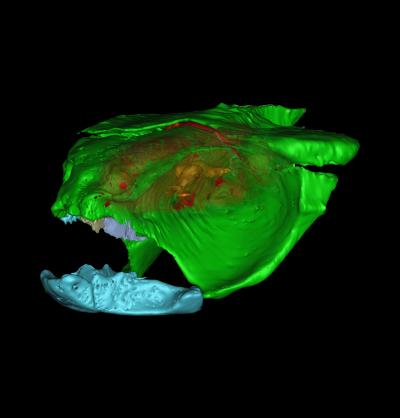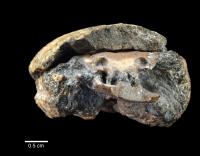- Home
- News
- General News
- Scientists discover...
Scientists discover the first fossil brain
03-03-2009
PRESS RELEASE- A 300-million-year-old brain of a relative of sharks and ratfish has been revealed by French and American scientists using synchrotron holotomography at the European Synchrotron Radiation Facility (ESRF). It is the first time that the soft tissue of such an old fossil brain has ever been found. The results are published in PNAS this week.
Share
As in many scientific discoveries, it all happened by chance. The team from the National Natural History Museum in Paris (MNHN in French), the ESRF and the American Museum of Natural History in New York was using the synchrotron to study one of the few skulls of an iniopterygian fish that has maintained its three dimensions (most of them are squashed). Inopterygians are an extinct relative of sharks and ratfish, and used to live on the shallow and muddy marine ground. They were not bigger than 50 centimeters.
The scientists used the technique of absorption microtomography to study different samples. One sample, stemming from Kansas (US), revealed a peculiar structure: it was denser than the surrounding matrix that fills the braincase, and which is made of crystalline calcite. In order to elucidate its structure in detail, they decided to use a second technique, X-ray holotomography. Surprisingly, the results showed a symmetrical and elongated object placed in the same position as a brain would have been. The 3D reconstruction showed different parts of the brain, such as the cerebellum, spinal cords or optic lobes and tracts, among others. The only part the researchers couldn’t spot was the forebrain, perhaps too thin to become mineralized.
 |
||
|
The structure of the skull (foreground) of a 300 million year-old iniopterygian fish from Kansas remotely related to living ratfish is elucidated thanks to holotomography, a technique based on synchrotron X-ray phase contrast imaging, and yields the first hint at an exceptional mineralization of the brain (orange). |
Further analysis of the fossil indicated that the area where the brain-like structure reaches the surface of the sample reveals a high concentration of calcium phosphate, whereas the surrounding matrix is almost pure calcium carbonate. The mineralization of the brain is, according to the main author of the paper, Alan Pradel, from the MNHN, “due to the presence of bacteria that covered the brain shortly before decay and induced its phosphatization”.
On top of this, the environmental conditions, probably saturated with calcium phosphate, the lack of oxygen in the braincase and the presence of fatty acids in the brain may have generated a fall in pH that also shifted the appearance of calcium carbonate in favour of calcium phosphate.
 |
 |
|
The brain fossil. Credits: PNAS |
The body of iniopterygians. Reconstruction of the fish, called Sibyrhynchus denisoni. Courtesy of PNAS. |
Scientists already knew that iniopterygians must have possessed a brain, but this new discovery can shed light on brain evolution during major evolutionary transitions, provided that other similar cases of exceptional preservation turn up in key fossils. This research also proves that, thanks to the use of microtomographic techniques in lightsources like the ESRF, details of the anatomical organisation of the nervous system in fossil brains are, from now on, potentially available.
Reference:
Pradel, A., et al, Skull and brain of a 300-million-year-old chimaeroid fish revealed by synchrotron holotomography, PNAS Early Edition, 2 March.
IMAGES:
IMAGE1
image1.tif
image1b.jpg
image1c.jpg
The structure of the skull (foreground) of a 300 million year-old iniopterygian fish from Kansas remotely related to living ratfish is elucidated thanks to holotomography, a technique based on synchrotron X-ray phase contrast imaging (background), and yields the first hint at an exceptional mineralization of the brain (orange).
Credits: PNAS/Philippe Janvier (CNRS, Museum National d'Histoire Naturelle).
Images1b.jpg and 1c.jpg are variations of image1.tif but without the background.
IMAGE2
image2.tif
image2b.jpg
Image of the fossil. Courtesy of PNAS.
IMAGE 3
image3.jpg
The body of iniopterygians. Reconstruction of the fish, called Sibyrhynchus denisoni. Courtesy of PNAS.
IMAGE 4
image4final.jpg
Superposition of the skull and the brain (inside) on the fish anatomy.
Courtesy of PNAS (the two images).
IMAGE 5
image5.jpg
The discovery of the fossil brain didn’t happen in a remote fossil zone, but on an ESRF experimental station (beamline). In this aerial view of the ESRF, the two buildings forward are two imaging beamlines. The experiments (and the discovery) took place on the one on the left. Courtesy of ESRF.
MOVIES
Braincase_lat.mov
Movie of the 3D reconstruction of the braincase (green), the endocranial cavity (red) and the brain (orange) in lateral view.
brain_lat.mov
Movie of the 3D reconstruction of detail of the posterior part of the orbit with the brain in a better resolution (from Holotomography imaging) in lateral view (purple: braincase, blue: endocranial cavity, orange: brain).
brain_dorsal.mov
Movie of the 3D reconstruction of detail of the posterior part of the orbit with the brain in a better resolution (from Holotomography imaging) in lateral view (purple: braincase, blue: endocranial cavity, orange: brain).
All movies courtesy of PNAS.



